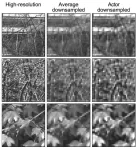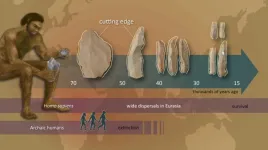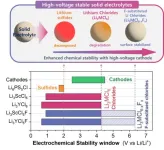(Press-News.org) The Sun’s polar regions were the most active emitting high energy radiation during the previous solar maximum, an imbalance yet to be explained, and reported for the first time in a study led by a researcher of the Faculty of Sciences of the University of Lisbon (Ciências ULisboa) (Portugal).
The Sun shines brightly in the visible light, but how does it look like at the highest energies of the electromagnetic radiation? The Sun’s picture taken in gamma rays is a deadly sight, luckily blinded by the Earth’s atmosphere and only seen from space. Each photon carries a billion times more energy than its ultraviolet sibling. How does the Sun’s regular gamma rays’ emission vary with time? And is it possible to link it to the periods of violent events we witness on the surface of our star?
A new study, published today in The Astrophysical Journal, produced a compressed fourteen years movie of the Sun observed in gamma rays, a visualization tool which revealed that, contrary to the expected uniform distribution of these high energy photons, the solar disk can become brighter on the polar regions. This tendency for the Sun’s glow in the gamma rays to be dominant at the highest latitudes is evident during the peak of the solar activity, as could be seen in June of 2014.
The study, led by Bruno Arsioli, of the Institute of Astrophysics and Space Sciences (IA), in Portugal, and the Faculty of Sciences of the University of Lisbon (Ciências ULisboa), may contribute to the understanding of the yet unknown process that makes the Sun shine ten times brighter in gamma rays than physicists expected. It might as well inform space weather forecasts.
Solar gamma rays are produced in our star’s halo and in solar flares, but also released from its surface. The latest were the focus of this study. “The Sun is stormed with close to light-speed particles coming from beyond our galaxy in all directions,” says Bruno Arsioli. “These so-called cosmic rays are electrically charged and are deflected by the Sun’s magnetic fields. Those that interact with the solar atmosphere produce a shower of gamma rays”.
Scientists thought these showers had equal chances of being seen anywhere across the Sun’s disk. What this work suggests is that cosmic rays might interact with the Sun’s magnetic field and thus produce a gamma-ray distribution that is not uniform across all latitudes of our star.
“We also detected a difference in energy between the poles,” Bruno Arsioli adds. “In the south pole there is a surplus of emissions of higher energy, of photons with 20 to 150 gigaelectronvolts, while most of the less energetic photons come from the north pole.” Scientists haven’t yet an explanation for this asymmetry.
During the maximum of the solar activity cycle, it is evident that gamma rays are being radiated more often at higher latitudes. They were particularly concentrated on the solar poles in June of 2014, upon the reversal of the solar magnetic field. This is when the Sun’s magnetic field dipole swaps its two signs, a peculiar phenomenon that is known to happen at the peak of solar activity, once every eleven years.
“We have found results that challenge our current understanding of the Sun and its environment,” says Elena Orlando, of University of Trieste, INFN, and Stanford University, and co-author of this study. “We demonstrated a strong correlation of the asymmetry in the solar gamma-ray emission in coincidence with the solar magnetic field flip, which has revealed a possible link among solar astronomy, particle physics, and plasma physics.”
The data used came from 14 years of observations with the gamma rays satellite Fermi Large Area Telescope (Fermi-LAT), between August 2008 and January 2022. This period covered a full solar cycle, from a minimum to the next, with the peak in 2014. One of the challenges was to disentangle solar emissions from the numerous other sources of gamma rays in the background sky, crossed by the apparent trajectory of the Sun. Bruno Arsioli and his colleague Elena Orlando produced a tool to integrate all the solar gamma-ray events within a window of the order of 400 to 700 days, and this window can slide across the 14-year period. Through this visualization (available in the media-kit below), the moments of polar excesses became clear, as well as the energy discrepancy between north and south.
“The study of gamma-ray emissions from the Sun represents a new window to investigate and understand the physical processes that happen in the atmosphere of our star,” says Arsioli. “What are the processes that create these excesses at the poles? Maybe there are additional mechanisms generating gamma rays that go beyond the interaction of cosmic rays with the surface of the Sun.”
Yet, if we stick to cosmic rays, they may work as a probe of the inner solar atmosphere. The analysis of these Fermi-LAT observations also motivates a new theoretical approach that should consider a more detailed description of the magnetic fields of the Sun.
The possible connection between the Sun’s production of gamma rays and its spectacular periods of more frequent solar flares and coronal mass ejections, and between these and the changes in the magnetic configuration of our star, may be an ingredient to improve the physical models that predict the solar activity. These are the basis of space weather forecasts, essential to protect instruments on satellites in space and telecommunications and other electronic infrastructures on Earth.
“In 2024 and the next year we will experience a new solar maximum, and another inversion of the Sun’s magnetic poles has already started. We expect by the end of 2025 to reassess if the inversion of the magnetic fields is followed by a surplus in the gamma rays emissions from the poles,” says Bruno Arsioli. Elena Orlando adds: “We have found the key to unlock this mystery, which suggests the future directions that should be taken. It is fundamental that the Fermi telescope will operate and observe the Sun in the coming years.”
But the solar gamma rays are likely to have more to reveal and demand further attention. This study now published will strengthen the science case for the continuous monitoring of the Sun by the next generation of gamma rays space observatories. “If it is settled that high energy emissions really carry information about the solar activity, then the next mission should be planned to provide real time data on gamma-ray emissions from the Sun,” says Arsioli.
END
Will this new solar maximum solve the puzzle of the Sun’s gamma-ray picture?
2024-02-07
ELSE PRESS RELEASES FROM THIS DATE:
A machine learning framework that encodes images like a retina
2024-02-07
A major challenge to developing better neural prostheses is sensory encoding: transforming information captured from the environment by sensors into neural signals that can be interpreted by the nervous system. But because the number of electrodes in a prosthesis is limited, this environmental input must be reduced in some way, while still preserving the quality of the data that is transmitted to the brain.
Demetri Psaltis (Optics Lab) and Christophe Moser (Laboratory of Applied Photonics Devices) collaborated with Diego Ghezzi of the Hôpital ophtalmique Jules-Gonin – Fondation Asile des Aveugles (previously Medtronic Chair in Neuroengineering at EPFL) to apply machine ...
Innovation in stone tool technology involved multiple stages at the time of modern human dispersals
2024-02-07
A study led by researchers at the Nagoya University Museum in Japan may change how we understand the cultural evolution of Homo sapiens at the time of their dispersal across Eurasia about 50,000 to 40,000 years ago. These findings challenge traditional beliefs about the timing and nature of cultural transitions during this critical period in human history.
Published in Nature Communications, the researchers’ insights into stone tool technology suggest that the commonly held view of a ‘revolution’ in culture and technology that allowed anatomically modern humans to outcompete ...
New study sheds new light on forests' role in climate and water cycle
2024-02-07
Forests, which cover a third of Earth's land surface, are pivotal in carbon storage and the water cycle, though the full scope of their impact remains to be fully understood. In a new study published in Nature Communications, researchers from Stockholm University and international colleagues provide new insights into the complex role forests play in the climate system and water cycle.
The research, involving scientists from 11 institutions across five countries, including Sweden, the UK, Finland, Germany, and Brazil, highlights the intricate relationship between forests, particularly their emission ...
Repetitive high concentration capsaicin patch applications for nerve pain in a real-world setting
2024-02-07
Capsaicin, derived from hot chili pepper plants, has been used to treat various types of pain, and a high concentration capsaicin patch (HCCP) is approved for the treatment of nerve (or neuropathic) pain. In a real-world study published in Pain Practice that included 97 outpatients in Germany diagnosed primarily with neuropathic back pain, postoperative/posttraumatic neuropathic pain, or postherpetic neuralgia (shingles pain), patients appeared to benefit from multiple HCCP applications.
Among the ...
Does gender affect food allergy’s impact on quality of life?
2024-02-07
An analysis of relevant published studies indicates that across all ages, food allergy negatively affects individuals’ quality of life to a greater extent in females than in males.
The analysis, which is published in Clinical and Experimental Allergy, included 34 studies. In the studies, women and the parents of girls tended to report a greater impact of food allergy on health-related quality of life than men or parents of boys.
Evidence also showed that improvements in quality of life over the course of treatment for food allergy can be different for males and females, with weak evidence suggesting that male children may experience more improvements ...
Does air pollution contribute to global cardiovascular disease–related deaths?
2024-02-07
A recent analysis of data from nearly all World Health Organization member states clearly demonstrates a link between air pollution and mortality from cardiovascular diseases, with more of such deaths associated with air pollution in low-income countries compared with high-income countries.
In all 183 countries included in the Chronic Diseases and Translational Medicine study, ischemic heart disease-related deaths attributed to air pollution were higher than stroke-related deaths caused by air pollution. In 2019, outdoor air pollution caused 16 ischemic heart disease-related deaths per 100,000 people in high-income countries compared with 70 per 100,000 in low-income countries.
Also, in ...
Researchers develop and test the first unmanned forestry machine
2024-02-07
A study published in the Journal of Field Robotics assessed the world’s first unmanned machine designed for autonomous forestry operations. Investigators demonstrated that using computer vision, autonomous navigation, and manipulator control algorithms, their newly developed machine can safely, accurately, and efficiently pick up logs from the ground and maneuver through various forest terrains without the need for human intervention.
The research represents a significant milestone in the field of autonomous outdoor robotics, which could reduce the need for human labor, thereby increasing productivity and reducing labor costs, while ...
KIST-LLNL raises expectations for commercialization of high-energy-density all-solid-state batteries
2024-02-07
Researchers are actively working on non-flammable solid electrolytes as a safer alternative to liquid electrolytes commonly found in lithium-ion batteries, which are vulnerable to fires and explosions. While sulfide-based solid electrolytes exhibit excellent ionic conductivity, their chemical instability with high-voltage cathode materials necessary for high-energy-density batteries has impeded their commercial viability. Consequently, there has been a growing interest in chloride-based solid electrolytes, which are stability in high-voltage conditions due to their strong bonding ...
Survey finds most don’t know the numbers that help predict heart disease
2024-02-07
COLUMBUS, Ohio – Keeping track of blood pressure, cholesterol and blood sugar levels can help identify risk factors for heart disease. However, a national survey by The Ohio State University Wexner Medical Center found that while many adults know their childhood address or best friend’s birthday, less than half know their blood pressure or ideal weight, and fewer than 1 in 5 know their cholesterol or blood sugar levels.
“Recognizing heart disease risk factors early and adequately treating ...
Artificial intelligence helps predict whether antidepressants will work in patients
2024-02-07
In patients with major depression disorder it is, thanks to use of artificial intelligence, now possible to predict within a week whether an antidepressant will work. With the help of an AI algorithm, a brain scan and an individual's clinical information, researchers from Amsterdam UMC and Radboudumc could see up to 8 weeks faster whether or not the medication would work. The results of this study are published today in the American Journal of Psychiatry.
"This is important news for patients. Normally, ...





